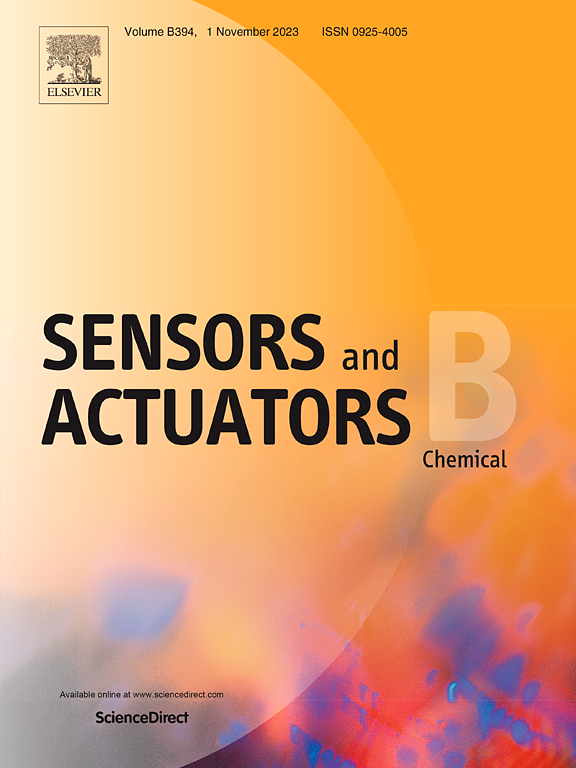同轴静电纺丝In2O3/TiO2核壳纳米纤维增强三乙胺传感
IF 8
1区 化学
Q1 CHEMISTRY, ANALYTICAL
引用次数: 0
摘要
三乙胺(TEA)是一种危险的易燃化合物,对人类健康和环境构成重大风险。因此,开发精确、快速的方法来检测复杂环境中的TEA是势在必行的。本文采用同轴静电纺丝的方法成功制备了不同质量比的In2O3/TiO2核壳纳米纤维。通过对不同配比[Ti]: [In](1:2, 1:1, 2:1和3:1)的表征和性能比较,发现基于Ti2In1的TEA传感器具有最佳的传感性能。其中,在280℃条件下,250.8 ~ 200 ppm TEA的响应值最高,响应/恢复时间最短(14/21 s),稳定性波动偏差最小(5.1%)。值得注意的是,该传感器通过将TEA与类似气体(如三甲胺、二甲胺和氨)区分开来,表现出优异的选择性和抗干扰能力。与原始TiO2和In2O3纳米纤维相比,Ti2In1传感器的优越性能可归因于其独特的核心(In2O3)-壳(TiO2)纳米纤维结构以及这些组件之间发生的界面电子转移过程,通过紫外光电子能谱(UPS)和x射线光电子能谱(XPS)测试证实了这一点。此外,电化学阻抗谱(EIS)和Mott-Schottky (MS) Nyquist测量证实了传感器优异的电子迁移性能。这些因素促进了气体分子的吸附、运输和反应,从而增强了TEA的传感性能。并进行了密度泛函理论(DFT)计算,得到了与实验结果一致的结果。本研究为探索TEA传感材料的形态操纵和内在机制铺平了道路。本文章由计算机程序翻译,如有差异,请以英文原文为准。

Coaxial electrospinning In2O3/TiO2 core-shell nanofibers for enhanced triethylamine sensing
Triethylamine (TEA), a hazardous and flammable compound, poses significant risks to both human health and the environment. Therefore, the development of precise and rapid methods for detecting TEA in complex environments is imperative. In this study, In2O3/TiO2 core-shell nanofibers (NFs) with different mass ratio were successfully obtained by coaxial electrospinning. Through the characterization and performance comparison of different ratio for [Ti]: [In] (1:2, 1:1, 2:1 and 3:1), it was found that the TEA sensor based on Ti2In1 owned the best sensing performance. Specifically, it demonstrated the highest response value of 250.8 to 200 ppm TEA at 280℃, the shortest response/recovery time (14/21 s) and the smallest stability fluctuation deviation (5.1%). Notably, the sensor exhibited excellent selectivity and anti-interference capability by distinguishing TEA from similar gases such as trimethylamine, dimethylamine, and ammonia. Compared with pristine TiO2 and In2O3 nanofibers, the superior performance of the Ti2In1 sensor can be attributed to its unique core (In2O3)-shell (TiO2) nanofiber architecture and the interfacial electron transfer processes occurring between these components, which were confirmed through ultraviolet photoelectron spectroscopy (UPS) and X-ray photoelectron spectroscopy (XPS) tests. Furthermore, electrochemical impedance spectra (EIS) and Mott-Schottky (MS) Nyquist measurement confirmed the sensor's excellent electron migration properties. These factors facilitated the adsorption, transport, and reaction of gas molecules, thereby in the enhancement of the TEA sensing performance. Moreover, density functional theory (DFT) calculation was executed and the same results as the experiment were obtained. This study paves the way for novel explorations into morphological manipulation and intrinsic mechanisms underlying TEA sensing materials.
求助全文
通过发布文献求助,成功后即可免费获取论文全文。
去求助
来源期刊

Sensors and Actuators B: Chemical
工程技术-电化学
CiteScore
14.60
自引率
11.90%
发文量
1776
审稿时长
3.2 months
期刊介绍:
Sensors & Actuators, B: Chemical is an international journal focused on the research and development of chemical transducers. It covers chemical sensors and biosensors, chemical actuators, and analytical microsystems. The journal is interdisciplinary, aiming to publish original works showcasing substantial advancements beyond the current state of the art in these fields, with practical applicability to solving meaningful analytical problems. Review articles are accepted by invitation from an Editor of the journal.
 求助内容:
求助内容: 应助结果提醒方式:
应助结果提醒方式:


